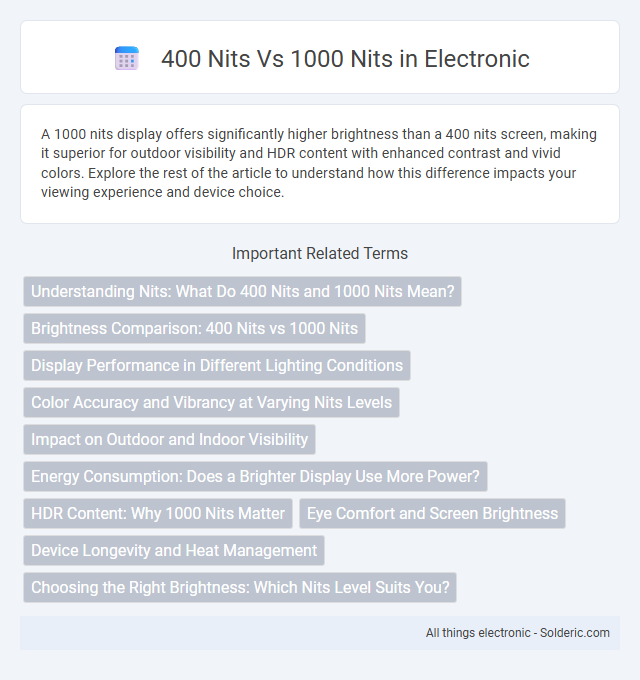A 1000 nits display offers significantly higher brightness than a 400 nits screen, making it superior for outdoor visibility and HDR content with enhanced contrast and vivid colors. Explore the rest of the article to understand how this difference impacts your viewing experience and device choice.
Comparison Table
| Feature | 400 Nits | 1000 Nits |
|---|---|---|
| Brightness Level | 400 nits (cd/m2) | 1000 nits (cd/m2) |
| Outdoor Visibility | Moderate, difficult under direct sunlight | Excellent, clear under direct sunlight |
| HDR Support | Limited or no HDR capability | Full HDR support with vivid highlights |
| Power Consumption | Lower power usage | Higher power usage, more heat generation |
| Typical Usage | Indoor use, office environments | Outdoor, professional media editing, premium devices |
| Price Impact | More affordable | Higher cost due to advanced display tech |
Understanding Nits: What Do 400 Nits and 1000 Nits Mean?
400 nits and 1000 nits measure screen brightness levels, where nits represent candela per square meter (cd/m2), quantifying luminance intensity. A display with 400 nits offers sufficient brightness for indoor use, while 1000 nits ensures superior visibility in bright environments, including direct sunlight. Understanding these values helps you select a screen that matches your viewing conditions and enhances visual clarity.
Brightness Comparison: 400 Nits vs 1000 Nits
A 1000 nits display offers significantly higher brightness compared to a 400 nits screen, providing clearer visibility in bright environments like direct sunlight. Your experience with HDR content will improve on 1000 nits panels, showcasing more vibrant highlights and better contrast. For indoor use, 400 nits is sufficient, but 1000 nits delivers superior performance under various lighting conditions.
Display Performance in Different Lighting Conditions
A display with 1000 nits brightness offers significantly better visibility in bright environments and direct sunlight compared to 400 nits, ensuring clearer images and more vibrant colors. Your ability to comfortably view content outdoors or in well-lit rooms improves as higher nit levels prevent screen washout and glare. While 400 nits suffice for dim indoor settings, 1000 nits enhance overall performance across variable lighting conditions.
Color Accuracy and Vibrancy at Varying Nits Levels
A 1000 nits display offers significantly higher brightness than a 400 nits panel, enhancing color vibrancy and maintaining accuracy even in well-lit environments. At 1000 nits, colors appear more saturated and true-to-life, with better contrast that reduces washout under direct sunlight. Conversely, a 400 nits screen may struggle to reproduce vivid colors and precise hues consistently when ambient light is strong, impacting overall visual clarity.
Impact on Outdoor and Indoor Visibility
A 1000 nits display offers significantly better visibility in direct sunlight and bright outdoor conditions compared to a 400 nits screen, reducing glare and improving readability. Indoors, both 400 nits and 1000 nits brightness levels provide sufficient clarity, but 1000 nits enhances contrast and color vibrancy, particularly in well-lit rooms. Devices with higher brightness levels, such as 1000 nits, are preferable for users who frequently switch between indoor and outdoor environments or require sharper visibility in various lighting conditions.
Energy Consumption: Does a Brighter Display Use More Power?
A 1000-nit display consumes significantly more power than a 400-nit display due to the increased backlight intensity required to achieve higher brightness levels. This elevated energy consumption can reduce battery life in portable devices like laptops and smartphones. Energy efficiency in displays depends not only on brightness but also on technology type, with OLED and LED variants showing varying power usage patterns at different luminance settings.
HDR Content: Why 1000 Nits Matter
HDR content benefits significantly from displays capable of 1000 nits brightness, as higher luminance enhances contrast, delivering vivid highlights and deeper shadows crucial for realistic visuals. A 400 nits display may struggle to accurately represent HDR's dynamic range, resulting in muted colors and less immersive imagery. Therefore, 1000 nits brightness ensures that HDR content is displayed with the intended intensity, improving detail visibility in bright and dark scenes.
Eye Comfort and Screen Brightness
A 400-nit screen provides sufficient brightness for indoor use, reducing eye strain by limiting excessive glare in low-light environments, which enhances overall eye comfort. In contrast, a 1000-nit display ensures superior visibility in bright or outdoor settings, maintaining clear image quality without forcing users to squint or strain their eyes. Choosing a screen with appropriate nit levels balances brightness needs and eye comfort, depending on the typical lighting conditions and usage scenarios.
Device Longevity and Heat Management
A display with 400 nits brightness typically generates less heat, contributing to better device longevity by reducing thermal stress on internal components. In contrast, 1000 nits brightness can cause increased heat production, potentially accelerating wear and requiring more advanced heat management solutions. You should consider these factors when choosing a device for extended use, as higher brightness may impact overall durability and performance.
Choosing the Right Brightness: Which Nits Level Suits You?
A display with 400 nits brightness suits indoor use and typical office or home environments, offering clear visibility without excessive power consumption. In contrast, 1000 nits brightness excels in bright settings, such as outdoor use or direct sunlight, ensuring vibrant colors and readability under challenging lighting conditions. Understanding your primary usage environment helps select the optimal nits level for balanced visual comfort and energy efficiency.
400 nits vs 1000 nits Infographic

 solderic.com
solderic.com